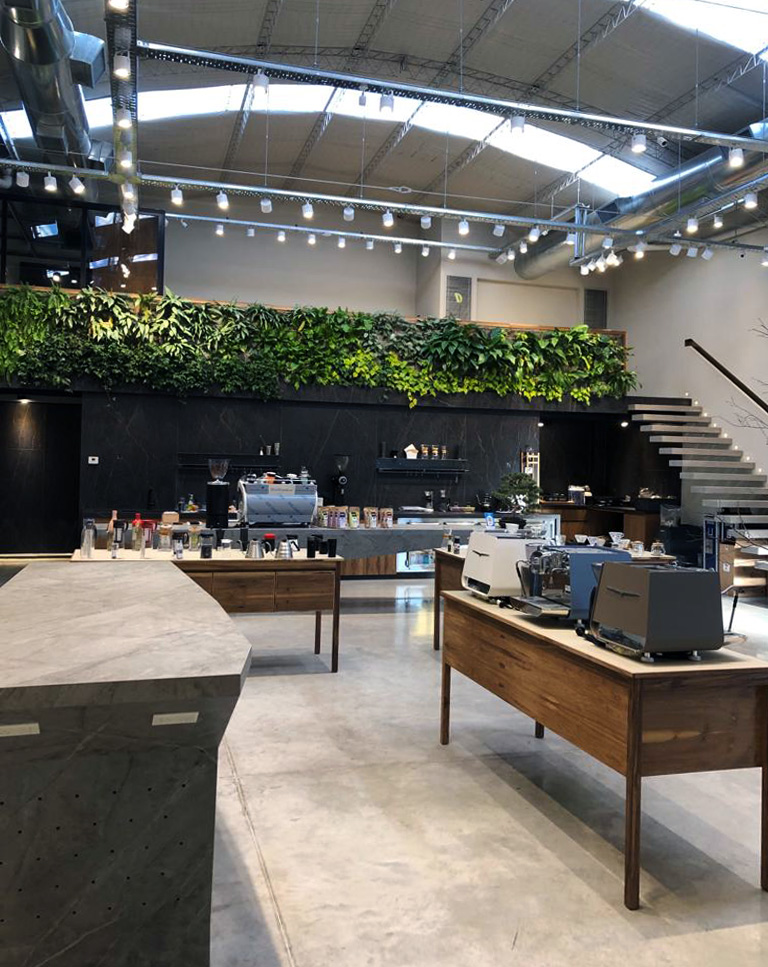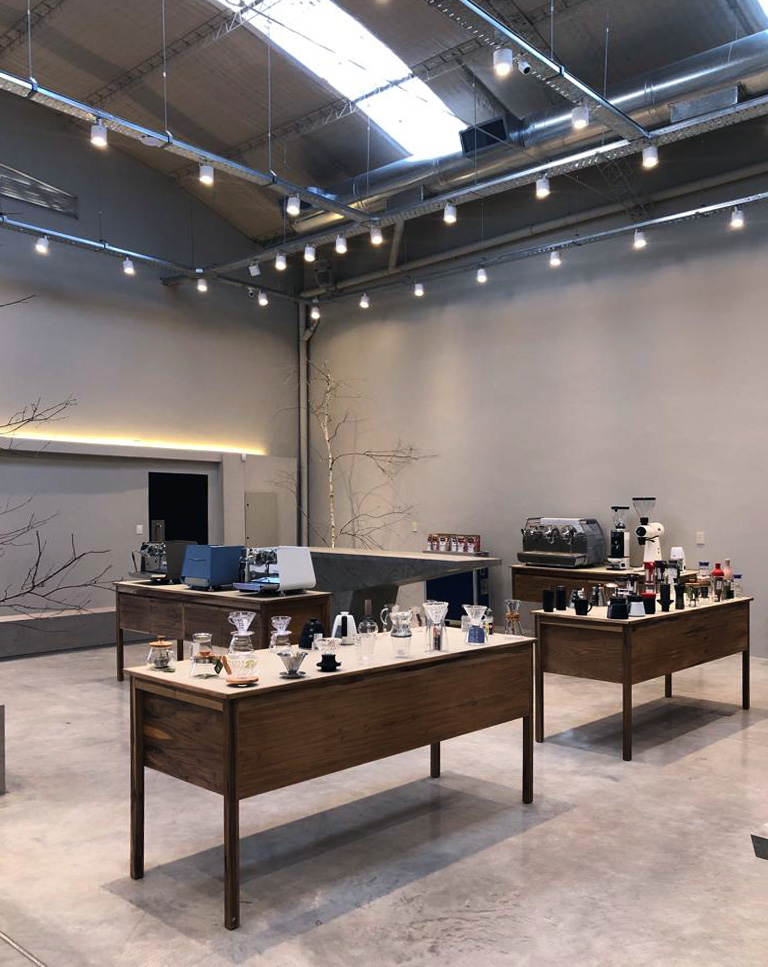
Whereas cheering on Anthony Douglas on the World Barista Championship a number of weeks in the past, we seen that most of the espresso photographs didn’t cut up equally between the 2 spouts. Does that appear loopy to you? These had been the nationwide Barista Champions of their international locations — among the most expert baristas on the earth — and but, the espresso didn’t all the time circulation evenly from both sides of the spout.
When most of us within the BH workplace had been studying easy methods to make espresso, we had been taught that if the espresso drops from one aspect of the spouts earlier than the opposite, it’s a certain signal of channelling or uneven flow through the puck. But we’ve always suspected that this wasn’t the whole truth. But after seeing all these unevenly split espressos from world-class baristas, we started wondering what causes this to happen. Is it somehow the barista’s fault, for messing up the distribution or tamping? Or could it be caused by the machine being tilted slightly to one side, or some deviation in the shape of the portafilter? And most importantly — does this difference actually matter?
So naturally, we decided to put it to the test. Tom Hopkinson, one of our staff writers, has been in South America helping us put together the Coffee Buyer’s Guide to Colombia. This week Tom paid a visit to Puerto Blest, one of the top specialty roasteries in Buenos Aires. They kindly allowed us to use their beautiful showroom for some experiments.
The showroom at Puerto Blest, in Buenos Aires
The Protocol
For the tests, we used a virtually brand-new machine (a Black Eagle Maverick), hopefully thereby avoiding any issues that might be caused by worn-down or crooked spouts in the portafilter, or damage to the dispersion screens or portafilter baskets.
We followed a set recipe of 18 grams dose and 45 grams yield in 28 seconds, weighing the dose to within 0.01 grams, and using the gravimetrics on the Black Eagle to control the yield. We used a very stable and consistent washed SL-28, from Finca Las Nubes in El Salvador, as the test coffee. We also verified that the machine was level to begin with, using a spirit level pressed up against the underside of the grouphead.
We then pulled five sets of espressos, with four pairs of double shots in each set.
For the first set, we kept the machine flat and level, and tamped the puck flat with a Puqpress. Then we pulled another set of shots, but this time tamped the puck manually, at an angle of around 15 degrees to the right. For the third set of shots, we lifted the legs of the machine on the left-hand side by about 1 cm, tilting the entire machine slightly to the right, again tamping flat with the Puqpress. For the fourth set, we used both a tilted machine and a wonky tamp together.
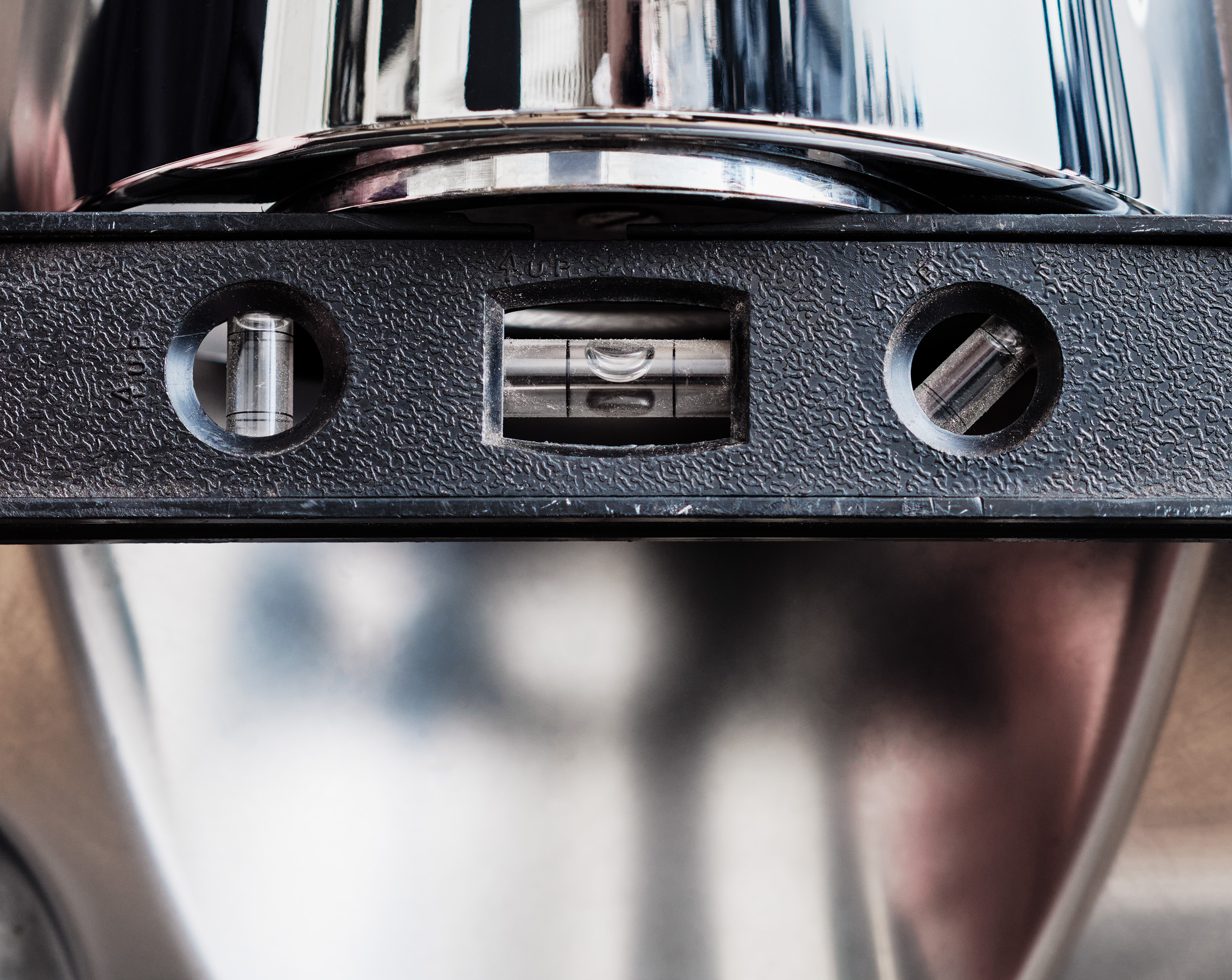 A perfectly level espresso machine. The easiest way to check that the machine is level is by using a spirit level on the underside of the grouphead.
A perfectly level espresso machine. The easiest way to check that the machine is level is by using a spirit level on the underside of the grouphead.
Finally, to see how much of a difference shot time makes, we tightened up the grind setting until the shot time reached 42 seconds, and pulled four more pairs of espressos. For these shots, we used a level machine and a flat tamp.
Leaning to the Left
For each pair of shots, we timed the difference in when the espresso dropped from each spout, weighed the espresso from each side, and measured the TDS. We averaged the results and used a 2-tailed T-test to check for significant differences. The results are in the table below.
| Espresso weight (g) | Espresso TDS (%) | Shot time difference (s) | ||||||
| Left spout | Right spout | Left spout | Right spout | |||||
| Machine level, tamp level | 23.8 | * | 21.8 | 7.62 | 7.26 | 0.8 | (LH first) | |
| Machine level, tamp askew | 23.6 | * | 21.9 | 7.47 | 7.59 | 0.4 | (LH first) | |
| Machine askew, tamp level | 22.1 | * | 23.6 | 7.65 | 7.73 | 0.1 | (RH first) | |
| Machine askew, tamp askew | 22.3 | 23.0 | 7.34 | 7.64 | 0.2 | (LH first) | ||
| Slow shot, machine and tamp level | 22.4 | 22.9 | 7.97 | 7.68 | 0.8 | (RH first) | ||
Asterisks between pairs indicate statistically significant differences (p<0.05)
The first thing we noticed was that even with the machine perfectly flat, and using a Puqpress for flat tamping, the left-hand cup tended to get the first few drops of espresso, and always ended up with a gram or two more espresso in the cup. The difference was small, but significant.
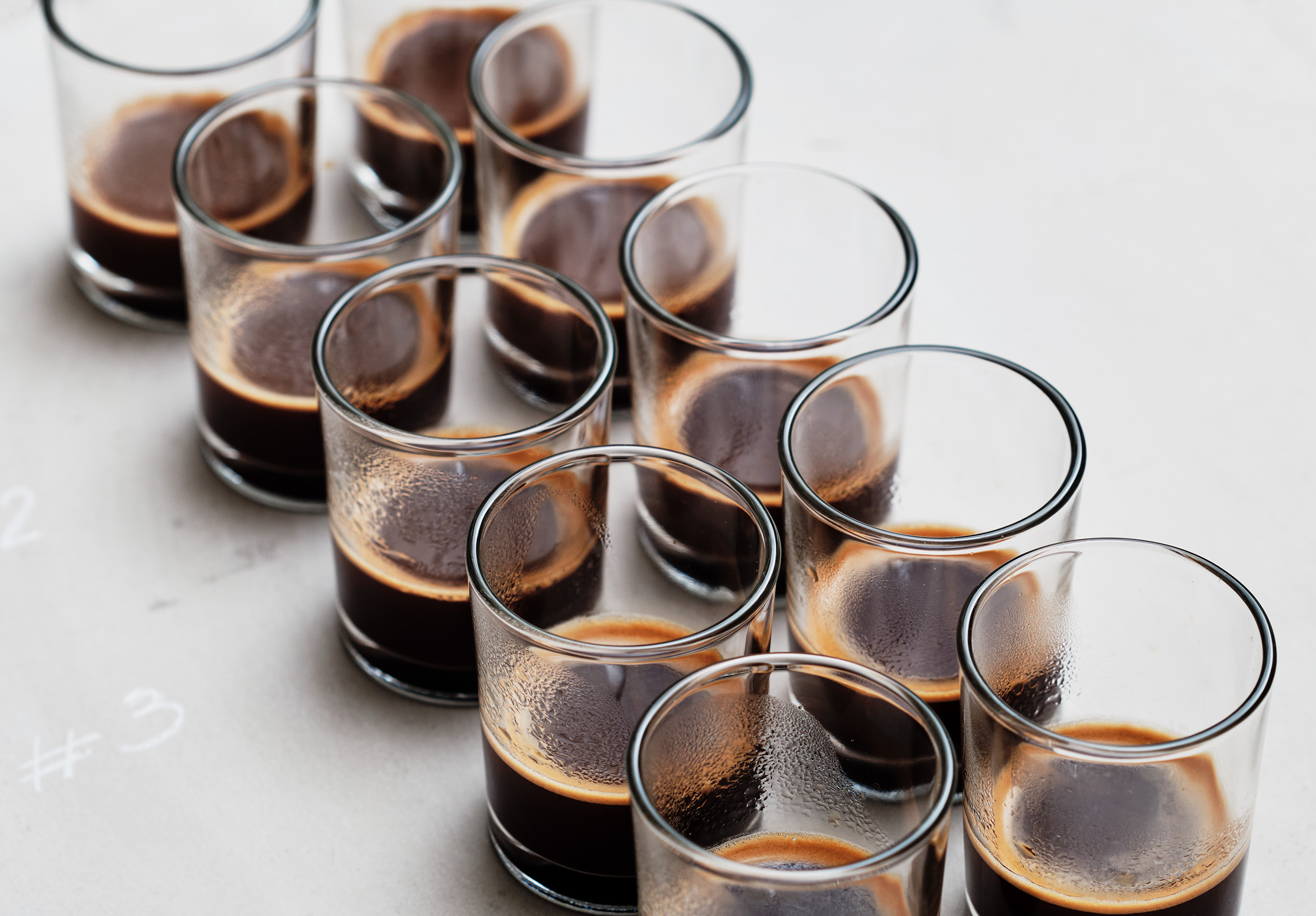 With the machine level, and using a flat tamp, the left-hand cup always ended up with a gram or two more espresso than the right-hand one
With the machine level, and using a flat tamp, the left-hand cup always ended up with a gram or two more espresso than the right-hand one
Of course, this could just indicate poor barista skills on our part, so we took it to the extreme with the wonky tamp. To our relief, this made no difference whatsoever.
We tamped far to the right, but the espressos still leaned towards the left-hand side.
If the theory about bad tamping or distribution causing the uneven split between shots were true, we would expect to see a big difference here. Tamping this far right, you might expect the espresso to flow from the right-hand side of the puck first, and thus to fall from the right-hand spout.
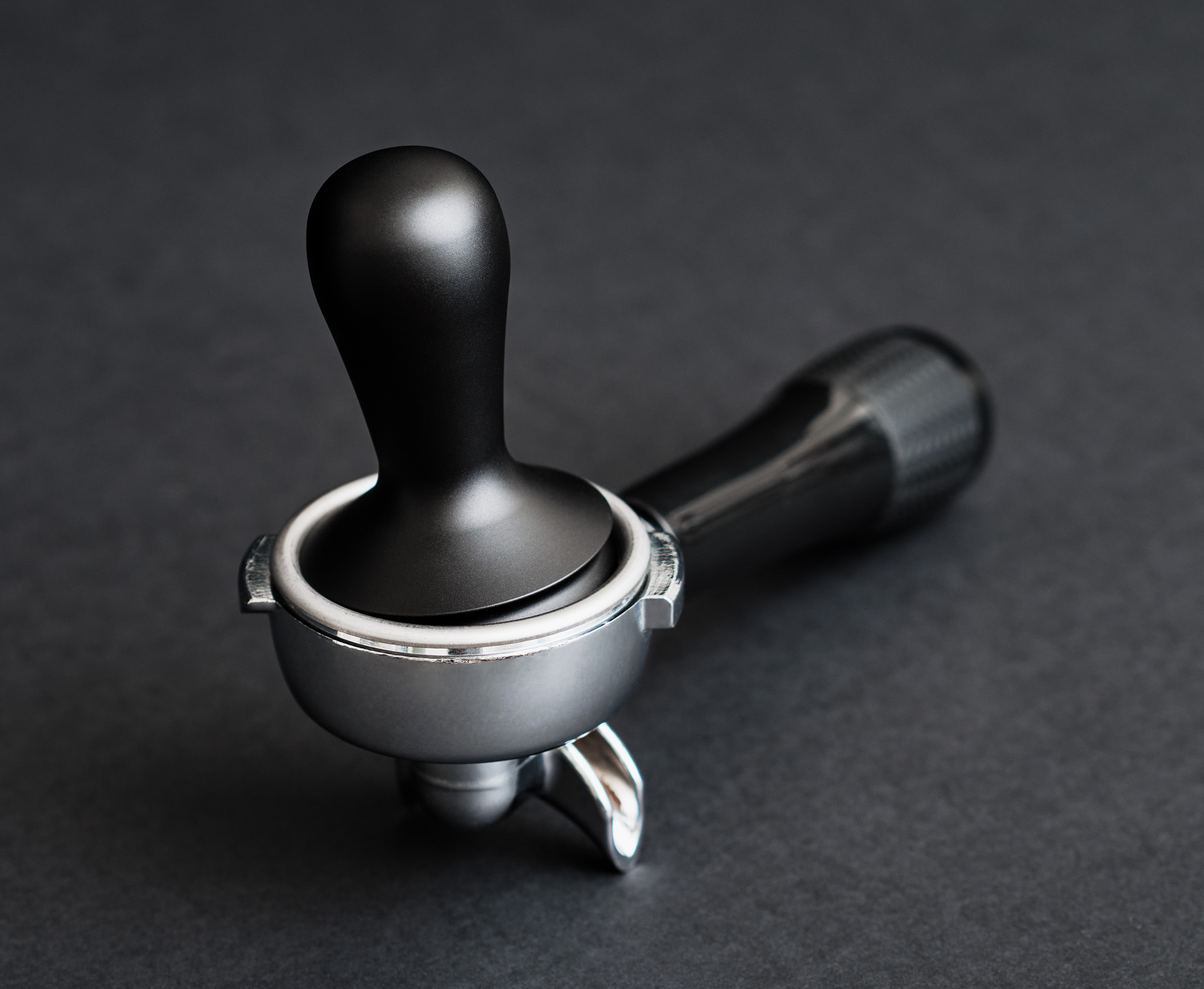 Even outrageously bad tamping has no effect on the way that espressos split from the spout
Even outrageously bad tamping has no effect on the way that espressos split from the spout
So if terrible tamping doesn’t change anything, what about tilting the machine? Lifting the machine by 1 cm on one side doesn’t sound like a lot, but it’s enough to make the machine visibly lop-sided — much more askew than you would see in any espresso bar.
We found that tilting the machine to the right did shift the balance of the espressos to the right-hand side — but a lot less than you might expect.
The right-hand cup ended up with more espresso, but the difference was less than a gram. The espressos tended to drop around the same time, as well.
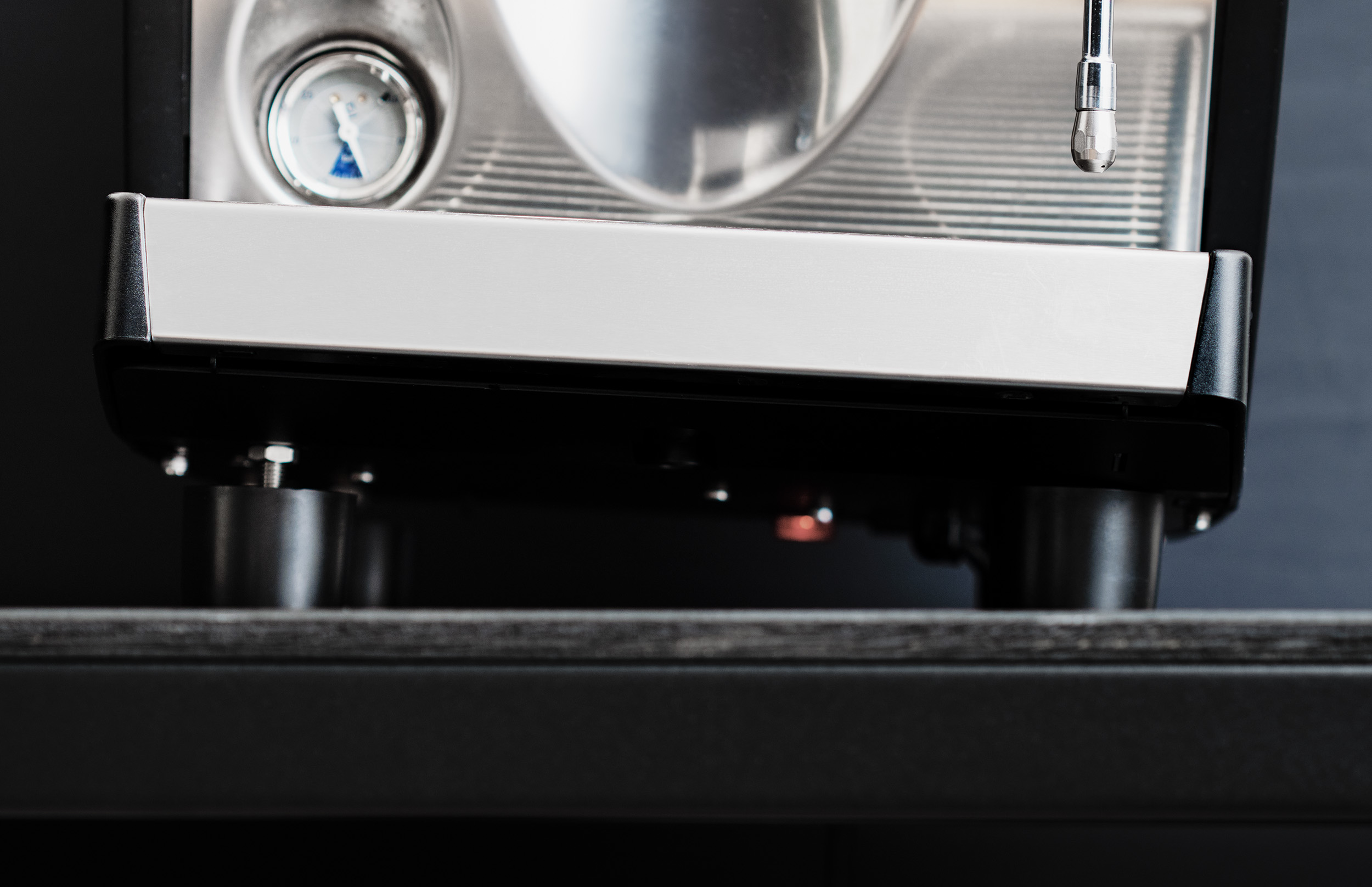 Tilting the espresso machine changes the way that the espresso splits from the spout, but the effect is much smaller than we expected
Tilting the espresso machine changes the way that the espresso splits from the spout, but the effect is much smaller than we expected
This suggests that while the angle of the machine makes a difference, the difference is not huge. The shots that we saw at the WBC dropping from one side, and then the other, probably has more to do with the design of the portafilter than it does with any issues with the machine position or the barista’s technique.
Furthermore, none of these changes made any significant difference to the TDS in the cup. We did see slight differences between cups, but there was no consistent overall pattern, so the differences we saw could be down to measurement error or some other factor.
When we tightened up the grind setting, we found that the slower shots tended to show a bigger difference between cups, both in the timing of the drop and the amount of coffee in each cup. Strangely, though, it didn’t follow the same pattern as the first set of espressos, but seemed to fall more randomly to one side or the other.
The Overall Picture
We also combined the results of all the shots, and looked separately at the effects of tamping at an angle or putting the machine at an angle.
Overall, tamping at an angle has virtually no effect. Tilting the machine, on the other hand, strongly affects how much espresso lands in each cup. It also might affect the difference in timing between each spout, although the difference we measured wasn’t statistically significant.
Since the first drops of espresso are very concentrated, we expected that whichever cup catches the first drops might have a higher TDS in the end, but we didn’t see any consistent effect. To our surprise, terrible tamping and tilting the machine also didn’t seem to reduce the overall extraction.
Whichever side drops first tends to finish with more espresso in the cup, but this wasn’t always the case. Even if both sides drop at the same time (to the extent that we could measure), there can be as much as 3 grams’ difference between cups.
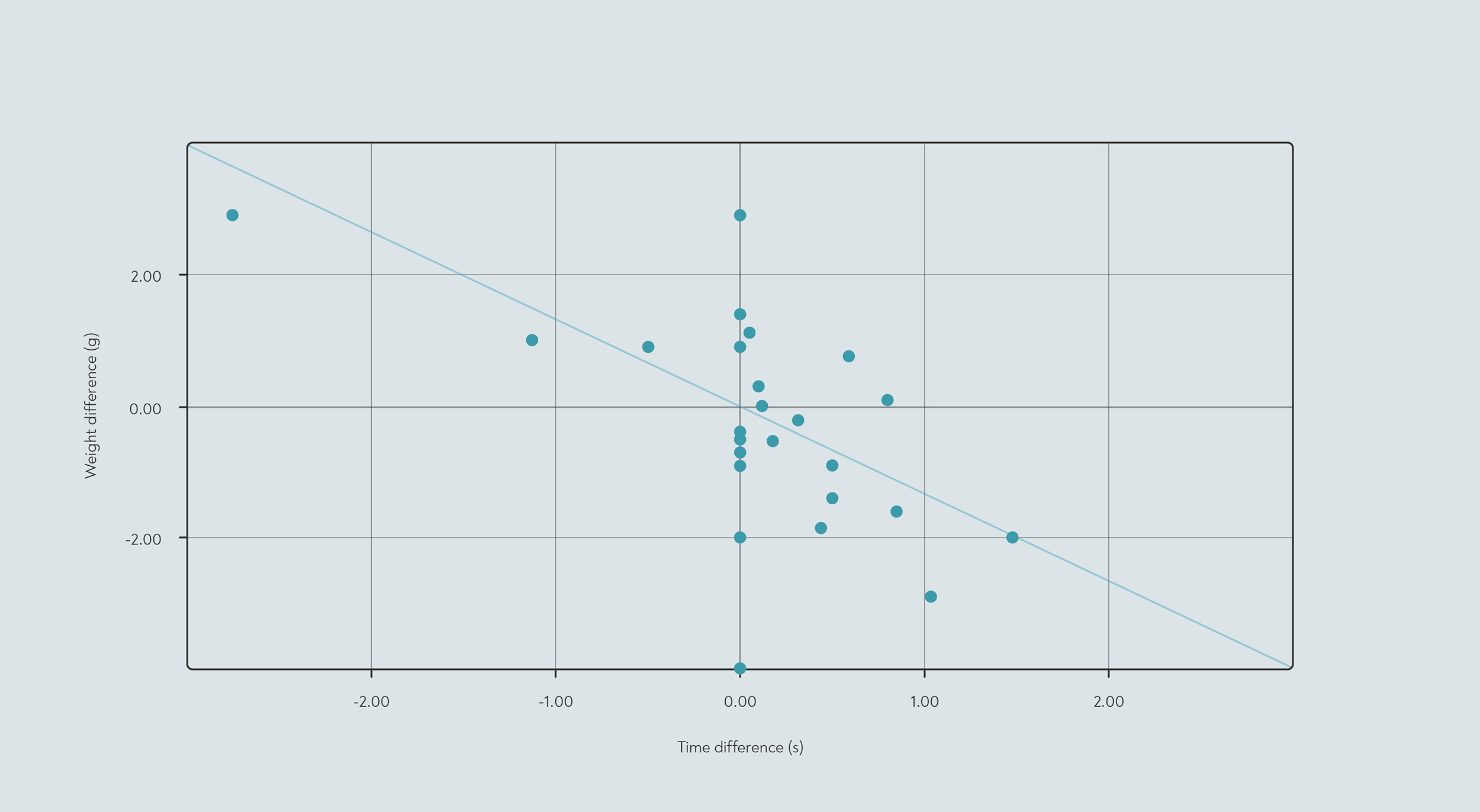 The first side to drop usually gets more espresso — but not always. Even with no measurable difference in when the spouts drop, the two cups can have up to 3 grams’ difference in weight.
The first side to drop usually gets more espresso — but not always. Even with no measurable difference in when the spouts drop, the two cups can have up to 3 grams’ difference in weight.
Taste Tests
While we worked, we also tasted pairs of single espressos side by side, and found some slight, but perceptible differences. In general, whichever cup caught the first drips of espresso had more body, and was often — but not always — more acidic. The second cup tended to be thinner in body. This occasionally translated into a cleaner, more transparent cup, but more often into an ’empty’ flavour.
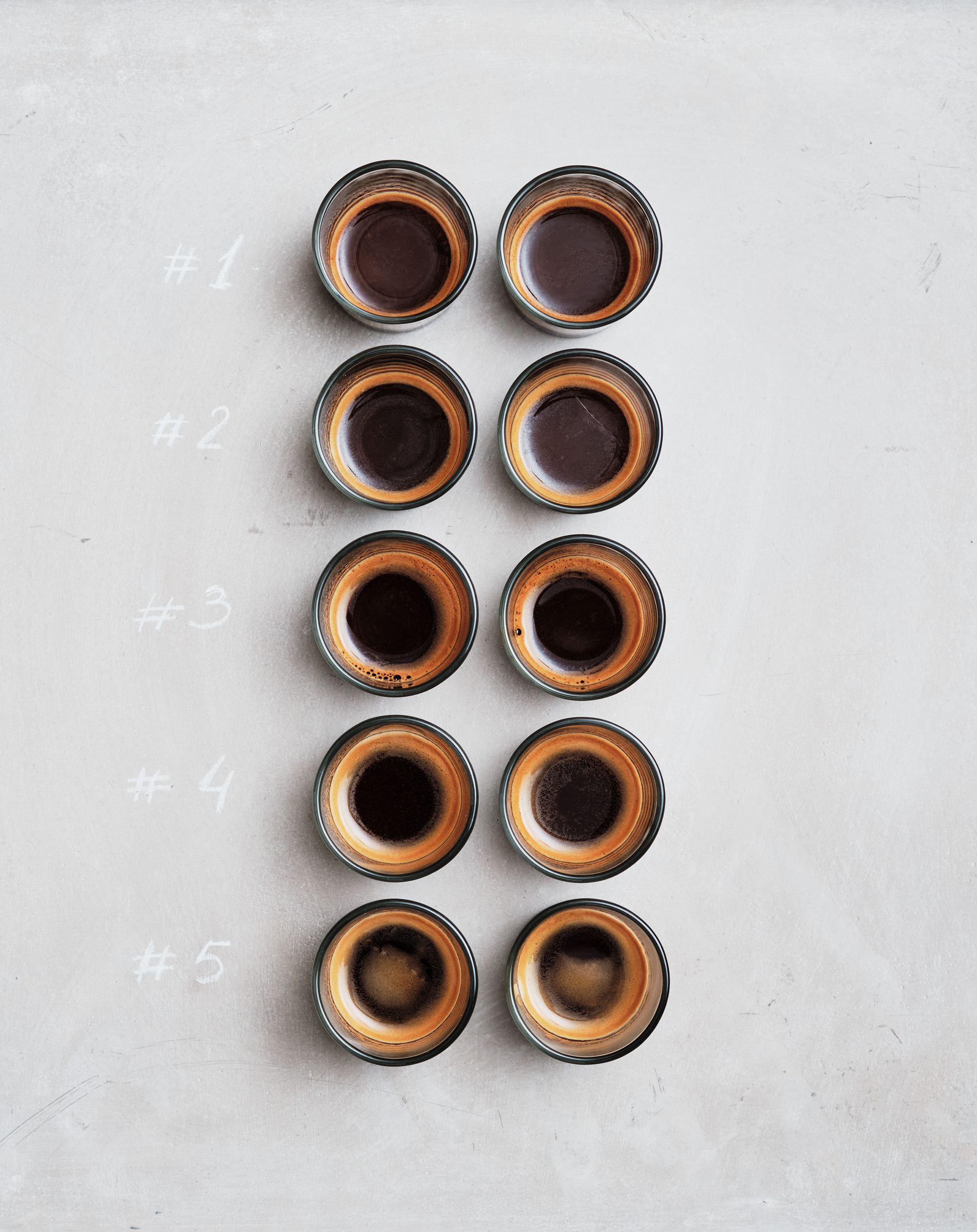 Matching pairs: while there was no consistent TDS difference between cups when shots split unevenly, there was a noticeable difference in flavour
Matching pairs: while there was no consistent TDS difference between cups when shots split unevenly, there was a noticeable difference in flavour
This suggests that the judges on a WBC panel are not always getting the same flavour experience. The differences in shot timing that we saw in our testing seemed quite small compared to what we’ve observed on other machines, so the taste differences could also be stronger on other machines.
The Single Espresso Takeaway
What does this all mean for baristas? The most important point is that if the espresso drops unevenly from the spouts, don’t assume it’s down to bad tamping or bad puck prep. Perhaps more importantly — don’t assume that just because the coffee drops evenly from the spouts, that means that your tamping was perfect!
If you find that the espresso consistently drops from one side first, however, your customers are getting slightly different experiences when they order single shots. Double check that the machine is level, and that your dispersion blocks and screens are clean and undamaged, and there isn’t any obvious damage to the basket or portafilter. If all of those are fine, then you might simply need to accept that a slight difference between shots is unavoidable.
For the World Barista Championship competitors, even a tiny difference in flavour between cups could be significant, considering that the WBC can be won or lost over a single point. If the shots drop from the spouts at different times, through no fault of the competitor, according to former WBC judge Gwilym Davies,
“It may be scored down under ‘Consistent dosing and tamping. Many times technical judges will tell the sensory judges if the shot they had came from an uneven split. This affects the sensory score difference between judges.”
While an uneven split between shots does seem to impact the flavour of the espresso, it’s unfortunate for competitors that there’s not much they can do to prevent it. For now, it seems that small differences in the flavour of single espressos are a fact of life — at least until someone designs a better portafilter that solves the problem.
